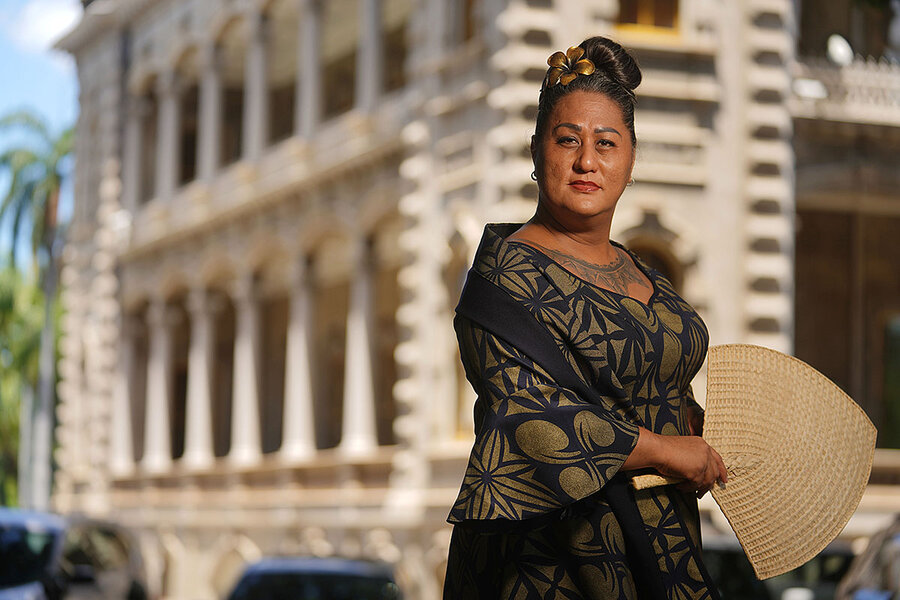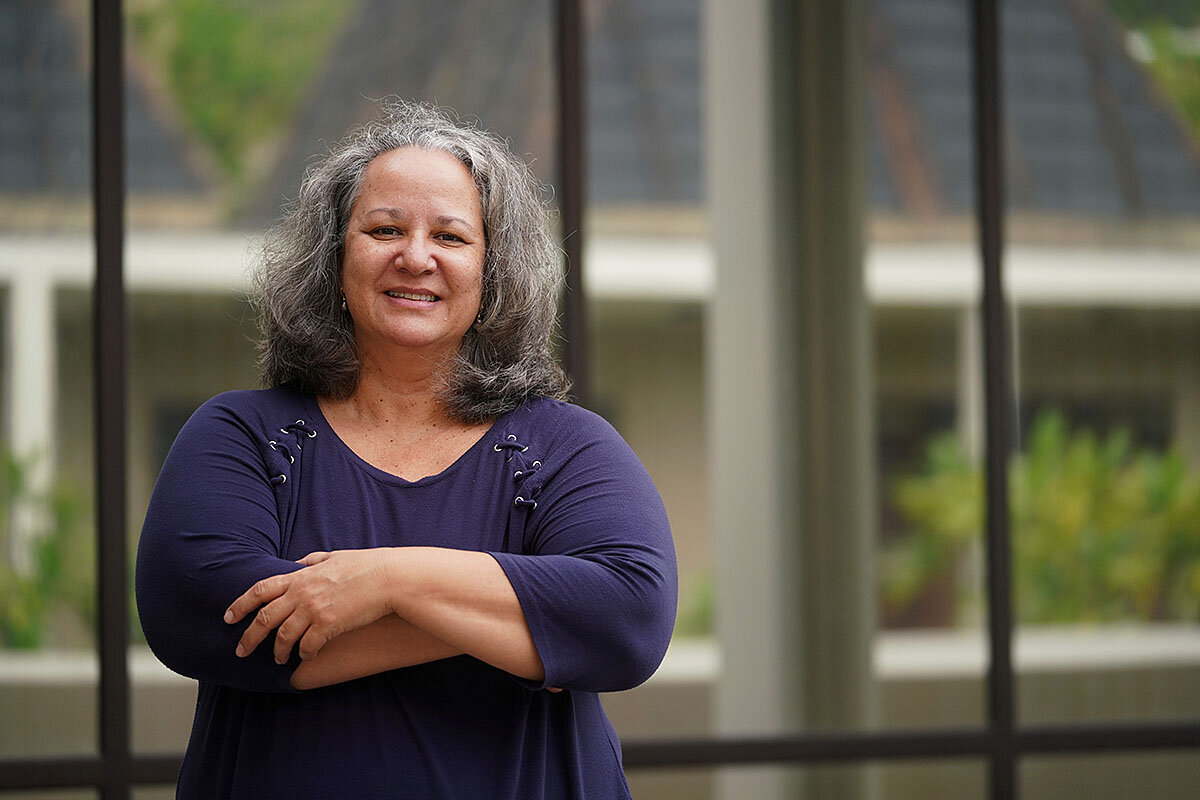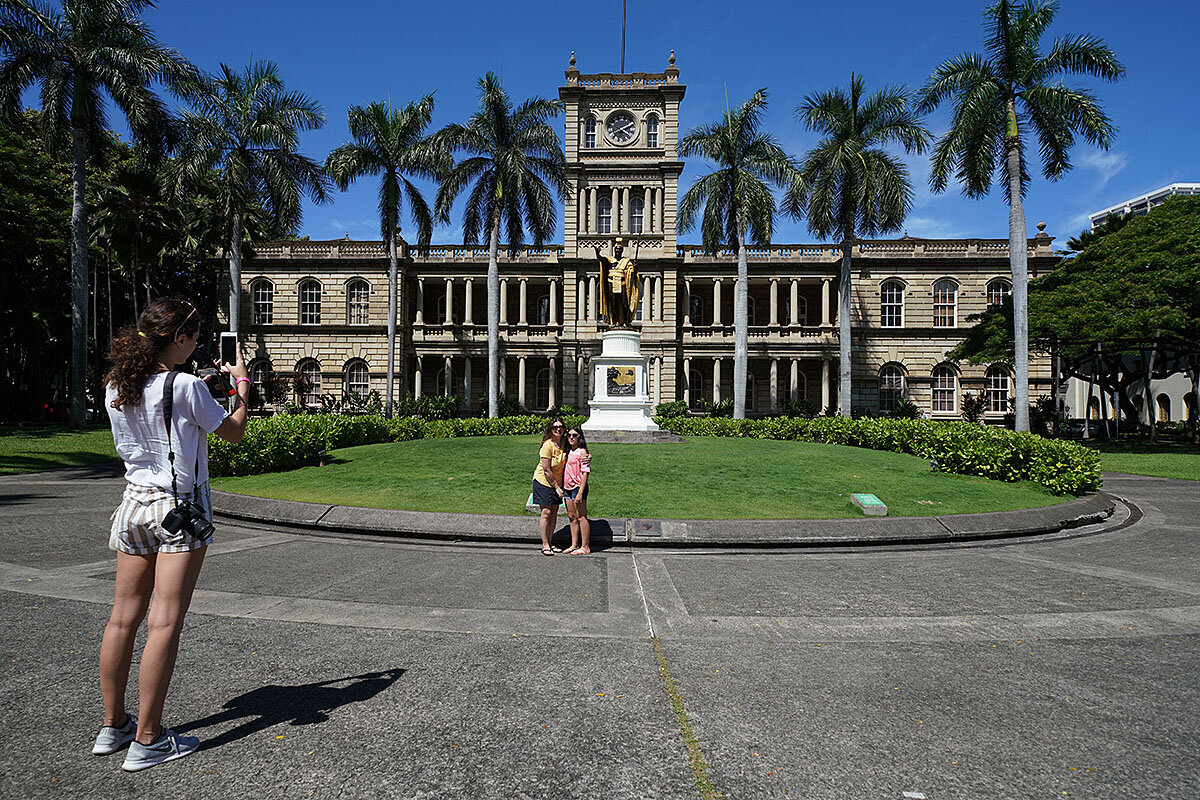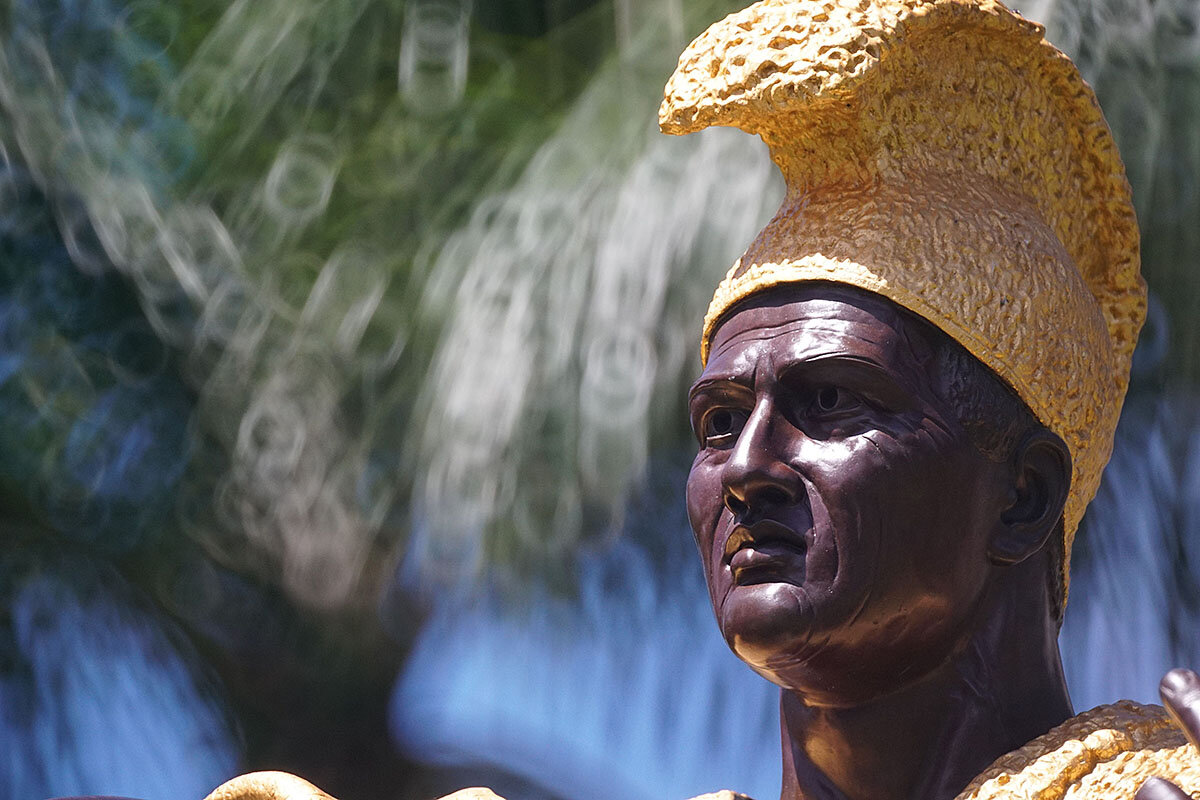Whose independence? Why some Native Hawaiians don’t celebrate on July 4.
Loading...
| Honolulu
This July Fourth, Hinaleimoana Wong-Kalu won’t be celebrating American freedom from Britain. She’ll be commemorating the loss of her ancestors’ independence at the hands of Americans.
As Americans gather in backyards and public parks around the United States, Ms. Wong-Kalu will be performing at the ʻIolani Palace, the cultural heart of Honolulu. There, she will be portraying Hawaii’s Queen Liliʻuokalani, who was imprisoned in the palace during the 1893 overthrow of the Hawaiian Kingdom by American businessmen and plantation owners. Within five years, the U.S. government annexed the islands, setting the stage for Hawaii to become the 50th U.S. state in 1959.
But Ms. Wong-Kalu doesn’t feel much like an American. She is first and foremost a Kanaka Maoli, or Native Hawaiian.
Why We Wrote This
What does American liberty mean? It depends on whom you ask. While Independence Day is a joyful celebration for many Americans, for some Native Hawaiians, it is a painful reminder of the loss of sovereignty.
“I feel a sense of duty and obligation to Hawaii because Hawaii is my homeland,” she says. “It is the heart of my existence. This is the part of my life that is my dominant identity.”
Connecting with that identity has not always been easy for Native Hawaiians. And for some, America’s Independence Day is a reminder of that separation from their heritage.
Today, Ms. Wong-Kalu works to inspire young Native Hawaiians to learn about their cultural roots as a kumu, or teacher.
Kumu Hina, as she is known throughout Hawaii, splits her time between correctional facilities and local schools, where she promotes the Hawaiian values of aloha: love, honor, and respect.
Talking story
“I’m going to tell you a story,” Konia Freitas says with a warm smile, her neck framed by a pink and red lei. “Talking story is important to us Hawaiians.”
“I was a little girl and my mother and I were watching TV, and a movie with Hawaiian subject matter was on,” she says. She can no longer recall the precise film but remembers watching as actors portraying the first American missionaries to arrive in Hawaii stepped off the ship, Thaddeus, in 1820.
“I was sitting at my mother’s feet and I heard a sniffling behind me. And I looked up and she was crying,” says Dr. Freitas. “But she wasn’t crying because she was sad.”
“‘This is when they stole all of our land,’” she recalls her mother seething through furious tears.
Throughout her childhood, Dr. Freitas heard this refrain with little explanation. It wasn’t until high school and college when she started branching her studies beyond the sanctioned curriculum that she began to understand the context for that sense of loss. Now the director of the Kamakakūokalani Center for Hawaiian Studies at the University of Hawaiʻi at Mānoa in Honolulu, she has devoted her work to furthering Native Hawaiian scholarship.
When the Hawaiian Kingdom was overthrown, the adult literacy rate in the Hawaiian language was nearly 100%, says historian Jonathan Osorio. Protestant missionaries had brought the Roman alphabet and the printing press in the 1820s. Their intent was to spread the study of the Bible. But the Hawaiian people soon began to devour Hawaiian language translations of classics such as “20,000 Leagues Under the Sea” and “Ivanhoe.”
In the decades that followed, several Hawaiian newspapers sprung up with news from around the islands and the outside world.
“American Christians brought the written word,” says Dr. Osorio, dean of Hawaiʻinuiākea School of Hawaiian Knowledge at the University of Hawaiʻi at Mānoa. “Hawaiians made [scholarship] into a national ethos.”
A cultural renaissance
Dr. Osorio, Ms. Wong-Kalu, and Dr. Freitas all came of age at a time when many young Native Hawaiians were beginning to reconnect with their history. After decades of emphasis on assimilation into American culture, they were rediscovering cultural traditions of hula, canoe building, and taro cultivation. Interest in learning the native tongue grew, inspired in part by a series of oral histories broadcast in Native Hawaiian over the radio by local Hawaiian language activist Larry Kimura.
Today, children with Native Hawaiian ancestry can enroll in Hawaiian language immersion programs, though instruction in Hawaiian history remains limited in public schools. A revived sense of scholarship has emerged as Native Hawaiian scholars have carved out a home at the University of Hawaiʻi.
And a quiet but emphatic sovereignty movement persists as a steady undercurrent throughout the Native Hawaiian community.
Ikaika Hussey supports the idea of Hawaiian sovereignty, but not just for Native Hawaiians. He imagines independence as a multicultural, inclusive, and socially democratic nation.
Historically, the Hawaiian Kingdom was an incredibly diverse nation, with citizens from all over Asia Pacific and the world. Mr. Hussey, like the majority of Native Hawaiians, is of mixed heritage.
“We’re all mixed race. I’m half Filipino,” says Mr. Hussey, a journalist and community organizer. “We’re all mixed up – in a good way.”
On the day the Hawaiian Kingdom was overthrown, a group of farmers of Chinese descent from the plantations of western Oahu marched in defense of Hawaii’s constitutional monarchy, Mr. Hussey says. The United States had just passed the Chinese Exclusion Act of 1882 halting immigration of Chinese laborers. Similar sentiments were pervasive throughout many European nations. In Hawaii, they had felt a welcome that they feared would disappear under U.S. control.
On the 100th anniversary of the overthrow of the Hawaiian monarchy, then-President Bill Clinton formally apologized to the Native Hawaiian people for the U.S.’s role in that coup.
“The problem with the apology resolution is that it is aimed at the wrong people: Native Hawaiians,” says Dr. Osorio. “In actuality it was the kingdom government, the sovereignty of this multiethnic state that was wronged.”
Dr. Freitas saw hope in that apology that a chance for political independence might soon be in sight.
But for others, like former state Rep. Hermina “Mina” Morita, the idea of sovereignty has other meanings.
‘We belong to the land’
“The issue of sovereignty and taking back the nation is really hard for me to grasp,” says Ms. Morita. “What I see as sovereign is how I conduct myself. It is where I can contribute not only to making a better life for Hawaiians, but for everybody in general.”
She doesn’t consider herself an activist, but she does see hope in the willingness of people to come out and not just participate in Native cultural practices but to defend them.
On the island of Kauai, where Ms. Morita lives, Native Hawaiian salt farmers have been lobbying the planning commission to block permits for a helicopter company to operate next to the salt beds on the west side of the island. The Native community has harvested paʻakai, or sea salt, from the Hanapepe Salt Ponds since ancient times.
Throughout the islands, Native communities are waging similar battles to protect the natural resources that they see as their birthright. A network of activists across the state is preparing to protest construction of the Thirty Meter Telescope atop the Big Island’s Mauna Kea, a sacred mountain to Native Hawaiians.
Seeing communities come out to help each other protect their natural resources is heartwarming, Ms. Morita says, because it represents a renewed embrace of environmental stewardship.
“We belong to the land,” she says. “That’s the most significant part of being Hawaiian; we are a part of this place.”
This story was produced with the assistance of local reporters Chad Blair, Anita Hofschneider, and Blaze Lovell at Honolulu Civil Beat as part of a pilot partnership between the Monitor and local newsrooms.









